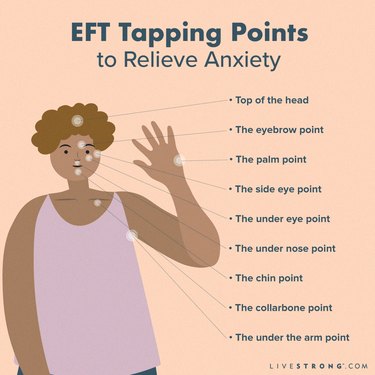
Between the stresses of work and the demands of everyday life, it can be easy to fall into a spiral of anxious thoughts and worst-case scenarios.
That's why, even with long-term mental health support like therapy, it's important to strengthen your stress-management skills with techniques like deep breathing, meditation or EFT.
Video of the Day
Video of the Day
EFT — or the Emotional Freedom Technique — involves tapping the body repetitively to address negative thoughts and calm stress hormones. It's often referred to as "tapping" for short.
"Tapping addresses the amygdala, or the fear center of the brain," says Amanda Stretcher, LPC-S, a licensed therapist at Choosing Therapy.
Tapping while focusing on an unwanted emotion or stressful situation helps send signals of safety to your mind, allowing you to feel safe enough to relax, Stretcher adds. "This also allows for a reduction in cortisol levels, which can help with anxiety."
Many people use EFT tapping in their daily lives to cope with emotional and physical stressors like anxiety or headaches, and it's also used in clinical settings for people with more severe mental health issues like PTSD and trauma, Stretcher says.
Below, we'll discuss the basics of EFT — what it is, how to do EFT tapping and the benefits.
What Is EFT Tapping?
EFT — sometimes referred to as "tapping" or "psychological acupressure" — is a somatic treatment meant to help soothe stress and strengthen the mind-body connection, Stretcher says.
Somatic therapies like EFT work by helping to release trauma and stress stored in the body, Stretcher adds, and often use a combination of body movement and thought practice to help people move through tension.
Like the traditional Chinese medicine practice of acupuncture, EFT uses meridian points — or energy centers — on the face and upper body to calm both your central nervous system and your mind. But instead of using acupuncture needles to access these meridians, EFT uses fingers to "tap" and apply pressure to the body.
As you tap, you repeat a phrase that both addresses and accepts the source of discomfort, per a January 2023 article in the Journal of Interprofessional Education & Practice. For example: "Even though I have a problem (e.g., stress, anxiety, etc.), I deeply and completely accept myself."
Both the tapping and phrase work together to regulate the nervous system and reduce "cognitive noise" or unwanted thoughts, says Melissa Miller, LMHC, a psychotherapist with FOLX Health.
Often, EFT is used as an in-the-moment coping skill to help with a broad range of symptoms, including pain, anxiety and depression, as well as physical markers of distress like high blood pressure, heart rate and cortisol levels, Miller says.
"Tapping allows for the body and mind to let go of negative emotions that arise from distressing occurrences," Miller says.
In fact, research has shown that EFT tapping is effective for managing anxiety, depression, PTSD and phobias.
And while research regarding EFT for physical symptoms is limited, there are some associations between EFT and an improvement in a variety of physiological systems, according to a February 2019 review in the Journal of Evidence-Based Integrative Medicine.
What Are the EFT Tapping Points?
Each EFT tapping point has its roots in traditional Chinese medicine and is believed to improve energy flow and bring balance to the body and corresponding internal organs.
In psychology, though: "It is thought these meridians may relate to the nervous system. Tapping these points may help you return to a regulated parasympathetic (or 'rest and digest') state," Stretcher says.
There are 12 meridian points in traditional Chinese medicine, and many more acupuncture points, but EFT focuses on nine major points, which include the following, per Miller:
- The palm point: side of the palm, directly below the pinky finger
- The eyebrow point: inner edge of each eyebrow, near the nose bridge
- The side eye point: the bone along either eye, below the eyebrow
- The under eye point: below either eye and on top of the cheekbone
- The under nose point: the area directly below the nose and above the lips
- The chin point: the crease between the chin and bottom lip
- The collarbone point: one inch below each collarbone
- The under the arm point: about one hand-width down from the armpit
- Top of the head: the crown of the head
Even with these nine points in mind, it's important to remember that EFT isn't limited to only these points. Rather, these points were chosen because they are easy to find, access and get into a routine with, Miller says.

How to Do EFT Tapping
The EFT technique combines the physical act of tapping and a mental exercise (or "set-up statement") to find physical and emotional comfort.
Here are the steps, according to Miller:
- Identify what you want to focus on. This could be something physical like a backache, or something causing emotional distress, like fear of missing an important work deadline.
- Rate the intensity of your feeling on a scale of 0 to 5, with 5 being the most intense.
- Create a set-up statement to address the issue. Your set-up statement should acknowledge the issue and its affect on you. Then, accept the issue. For example, if you are concerned about missing a work deadline, Miller suggests a statement like, "Even though I am worried, I accept how I feel."
- Starting with your palm point, tap the area and repeat your set-up statement three times. Ideally, you are tapping each point only five to seven times, so if your set-up statement is long, Miller recommends shortening your statement as you tap your various points to something simple like, "anxious about deadline."
- Then, move through the other eight tapping points while repeating your set-up statement. One full EFT sequence includes all nine points.
- Afterward, take a moment to rate your feelings on a scale of 0 to 5, and compare how you feel before and after.
- Repeat more EFT sequences until your score is lowered to a comfortable amount.
- Then, if needed, repeat the tapping points using affirmations. For example: "I am safe," or "I choose to let go of this anxiety."
The Benefits of EFT Tapping
While EFT is still being researched, there are a few studies that show tapping is an effective treatment for mental health issues — even for people who experience acute PTSD.
There are not many studies on EFT and PTSD in particular, but one older, stand-out February 2013 study from the Journal of Nervous and Mental Disease found that EFT significantly reduced psychological distress in veterans with PTSD. Even more impressive, after only six EFT sessions, researchers found that 90 percent of veterans involved no longer met clinical PTSD criteria.
Other research has found EFT to be helpful for the following, according to Purdue University:
- Anxiety
- Depression
- Stress
- Anger
- Physical pain
- Food cravings
And while the research is greatly limited and more studies need to be done, the previous Journal of Evidence-Based Integrative Medicine review suggests EFT tapping is potentially associated with some physical improvements in the body — like reduced blood pressure, cortisol levels and food cravings possibly tied to stress eating (which may aid in weight-loss efforts).
When to See a Therapist
EFT tapping can be a great method to help neutralize anxiety and stress in the moment. But if your mental health issues feel persistent and are interrupting your daily life, you may need to seek the support of a mental health professional.
"The best time to seek professional help is when you notice the effect of symptoms on your daily life — i.e., you're missing work or school, you're getting poor sleep, you're worrying excessively or you're feeling overwhelmed due to your anxiety and/or other mental health symptoms," Miller says.
Additionally, if you're noticing changes in daily habits like eating or sleeping too much or not enough, trouble concentrating, social withdrawal or extreme mood swings, Miller says these are all signs to see a mental health provider, too.
"The great news is that many mental health issues like anxiety and depression are very treatable with the right providers," Miller says. "There are evidenced-based approaches that qualified professionals can deliver to help clients live full and meaningful lives."
And ultimately, you can continue using EFT tapping on top of therapy and/or medication if you find that it helps you in your day-to-day life.
- Journal of Interprofessional Education & Practice: "Emotional Freedom Technique (EFT): Tap to relieve stress and burnout"
- Journal of Nervous and Mental Disease: "Psychological trauma symptom improvement in veterans using emotional freedom techniques: a randomized controlled trial"
- Purdue University: "Emotional Freedom Technique: Research supports benefits of tapping for mental health"
Is this an emergency? If you are experiencing serious medical symptoms, please see the National Library of Medicine’s list of signs you need emergency medical attention or call 911.


